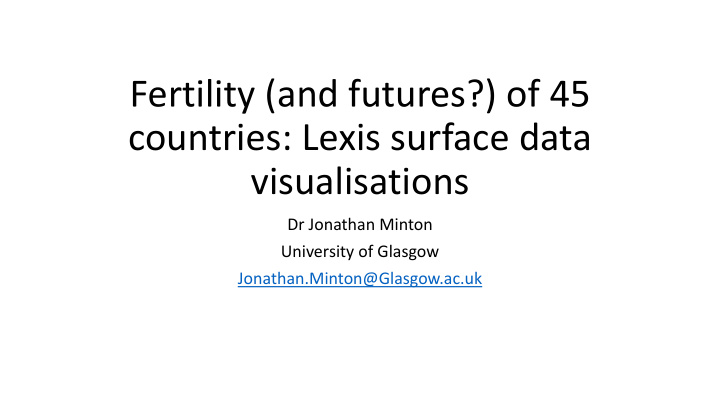



Fertility (and futures?) of 45 countries: Lexis surface data visualisations Dr Jonathan Minton University of Glasgow Jonathan.Minton@Glasgow.ac.uk
Acknowledgements • Serena Pattaro, University of Glasgow • Laura Vanderbloemen, Imperial College London • Nick Bailey, University of Glasgow • Gwilym Pryce, University of Sheffield
Introduction: Fertility in Europe • Fertility has been declining • There are differences between European regions • … And between Europe and other parts of the world
Introduction: Lexis Surfaces • Share the challenge and techniques of map-makers • How to visually represent three dimensional relationships on a two dimensional surface • Treating time like space • Spatial maps have latitude and longitude • Temporal maps (Lexis surfaces) have absolute time and relative time • Absolute time: year • Relative time: time since birth, time since first child, time since leaving education, etc
https://ije-blog.com/2016/06/27/lexis-cubes-1-from-maps-of-space-to-maps-of-time/
Demographic definitions of fertility • Not about biological potential, but about ‘realisation of outcome’ • Age-specific fertility rates • Number of live births/woman of age x in period (year/birth year) y • (Various technical complications about defining age and period: squares, triangles or parallelograms) • Schedule of fertility rate with age • Total fertility rates as a period-based measure
Period measures and cohort measures • Total fertility rates as a period-based measure: • Observations of schedule of age and fertility rate observed in a period • Effectively produces a ‘synthetic cohort’ • (n.b. biological and demographic uses of the term ‘period’ are distinct)
Period measures and cohort measures • Real cohorts are birth cohorts • Total fertility of 1920s cohorts: known • Total fertility of 1980s cohorts: unknown • Important unknowns • Time to first birth • Interval between births (Tempo changes)
Methods: data • Human Fertility Database: http://www.humanfertility.org/ • Human Fertility Collection: http://www.fertilitydata.org/ • Preferential ‘munging’ of the two: • 1) HFD; • 2) HFC: • i) STAT: Official statistical data : Data that come from statistical publications and official websites of national statistical offices • ii) ODE: European Demographic Observatory (L'Observatoire Démographique Européen) • Reference: http://www.fertilitydata.org/cgi-bin/collections.php • Additional ‘munging’ to impute ASMRs in more recent missing years
Methods: Software • R with Github • R packages: • Lattice/LatticeExtra: main maps • R2stl: 3D printable STL files (HFD only) • Wickhamese packages – readr, tidyr, stringr, dplyr, purr – for general data management and automation • Github • https://github.com/JonMinton/comparative_fertility/ • https://github.com/JonMinton/Statistical_Sculpture/
Methods: Producing cumulative cohort fertility rates • Given ASFRs, at what age do different birth cohorts ‘achieve’ a given number of children? • CCFRs of 1.30, 1.50, 1.80, and 2.05 are highlighted as contours • 2.05 = ‘replacement fertility levels’ • The 1.30 line always below 1.50 line, 1.50 below 1.80, 1.80 below 2.05 • If a contour line is not visible for a particular birth cohort, that birth cohort did not achieve that cumulative fertility rate • If 2.05 line not visible: long term ageing and declining population • For the final latticeplot – country tiles are coloured by region, and arranged by fertility rate in last year
Methods: Graphs produced • Heatmaps/level plots of ASMRs given age and year • Contour maps of ASMRs given age and year • Heatmaps/level plots of ASMRs given age and birth year • Cumulative cohort fertility maps • Contours giving CCFRs, colour/shade giving ASMRs • CCFR latticeplot for all countries
Results
Discussion: Methodological Contributions • Much data can be shown and made sense of at a time • Nearly 100 000 values represented in the latticeplot • Complex data vis: A need to slow… down • Guiding through steps • Intuitive sense of where different countries are heading • Plotting of contours gives an approximate sense of trajectories: • Extrapolate iff age < 42? Vertical if age >= 42? • Ordering in latticeplot is for last year but implied trendlines suggest which are stabilising and which are changing
Discussion: Substantive Contributions • Most (‘developed’) countries do not achieve replacement fertility levels • Countries that have include: Albania, Iceland, Ireland, New Zealand, USA, Norway? • No strong overall relationship between countries’ CCFRs and regions • Southern and Central European countries tend have low fertility • Small countries with relatively high fertility • Ordering in latticeplot is by fertility in last year, but lines show different trajectories
Discussions: Speculations • Primary and secondary effects of migration • USA fertility recovery and Mexican immigration? • Germany, Austria and openness to migration • Differences between Scotland and England/Wales (‘Wangland’) • Regional differences within countries • London and the rest
Discussion: Refugee Crises and European Demographic Trajectories • Almost all European countries need migration to stabilise dependency ratios • Primary effects: More 25 year olds now • Secondary effects (perhaps): higher fertility rates so more 25 year olds in the next generation • Within EU, countries with lower fertility appear more accepting of refugees • Austria, Germany, Italy?
Discussion: Brexit • Brexit: Mass migration is the solution to long-term decline in Europe, not the problem • As long as • short-term costs • regional variations in service demand • - can be mitigated appropriately • Conservatives: Austerity • Labour (or a bit of it): Migration Relief Fund • Scarcity: “Charity begins at home”
For further information • NCRM podcast: • http://www.ncrm.ac.uk/resources/podcasts/view.php/Visualising-social-trends-in-3D • Blogs: • https://ije-blog.com/2016/06/27/lexis-cubes-1-from-maps-of-space-to-maps-of-time/ • https://ije-blog.com/2016/06/27/lexis-cubes-2-case-study-log-mortality-for-males-in-finland- 1878-to-2012/ • Papers: • http://www.ncbi.nlm.nih.gov/pubmed/24062300 • http://jech.bmj.com/content/early/2016/03/01/jech-2014-205226.abstract • http://www.sciencedirect.com/science/article/pii/S1877584514000173 • Github repos (as before) • Or… email Jonathan.Minton@Glasgow.ac.uk • Thanks for listening!
Recommend
More recommend